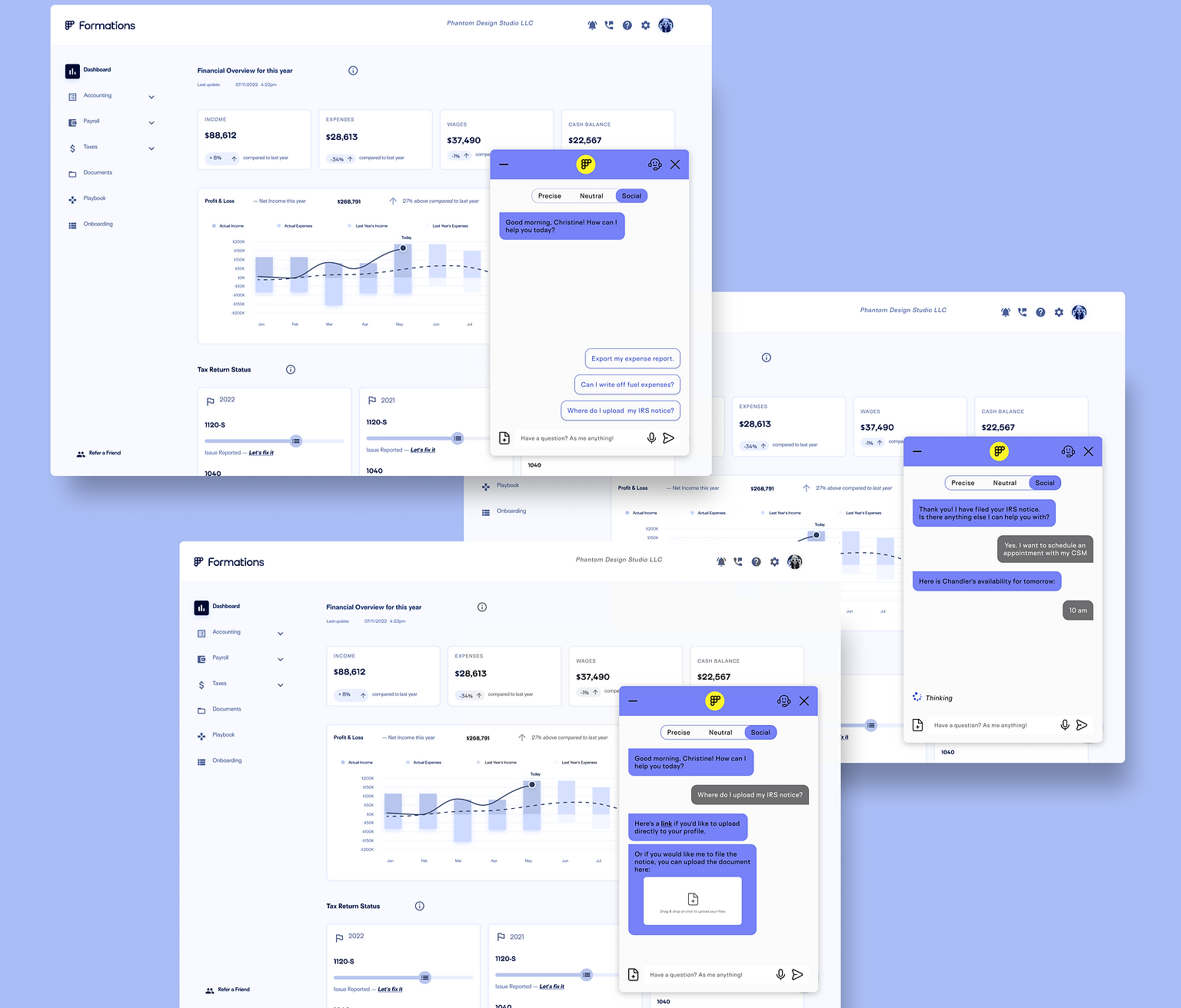
Using AI to Create Harmonious Financial Conversations
Role
-
UX Designer
Type
Client project
4 UX designers
Proof of Concept
Tools
-
Figma
-
Miro
-
Zoom
Timeline
-
3 weeks
The Solution

A sophisticated chat window with designs that represent advanced capabilities.
Why Now?
The client, Formations, aimed to expand nationally but faced profitability challenges with hiring more staff to handle the growing customer base. Their solution was to implement an artificial intelligence (AI) assistant or bot that could alleviate the workload on Customer Service Managers (CSM), enabling the business to accommodate more clients without additional staff.
Who is Formations?
Formations is a financial management company serving self-employed clients who have steady six figure incomes. Formations assists their clients in optimizing savings and avoiding unexpected financial challenges.
What was the users problem?
While keeping with the idea of using an AI assistant the users problem was determined from the Formations provided persona and usability testing.
Self-employed individuals earning a six-figure income require prompt and effective solutions for their tax inquiries, to streamline decision-making processes, and optimize time management to make informed business choices.
Business Goals
01.
Design an AI application that has a finance and tax knowledge base.
02.
Personalized client recommendations that are available 24/7.
03.
Seamless handoff to human support from the AI assistant.
Challenges
In the face of time constraints and a lack of comprehensive information, we encountered obstacles that required prompt and decisive action, without the complete data needed for well-informed ideas and plans.
Business Ambiguity
Formations were uncertain about their needs and didn't always provide clear responses to questions.
Lack of AI Knowledge
The lack of AI knowledge and understanding made it difficult to formulate applicable questions.
Minimal User Research
The design process began in a more general manner because of limited user research.
Chatbot Best Practices
To gain some inspiration for the design, I led the research to identify best practices in chatbots amongst competitors. I focused on conversation initiation, location, and operation indicators.
Prompts
Used to initiate conversation, communicate the AI's capabilities and ease the burden of mental load.
Placement
On the lower right corner of the page and often accompanied by a message bubble. The chatbot is easily located and signals that it can help.
Processing
Statements that outline the steps the AI is completing to inform users about its actions.
Designing for our User
When designing the wireframes we used insights from the persona to inform the design. The main insights we focused on were eliminating decisions for users, providing personalized recommendations, user guidance, and task status. Users main motivation when interacting with Formations is to save their time and effort for their business.
After considering the insights and adhering to chatbot best practices, we started crafting a preliminary design for testing with Formations' customers and staff. The AI Assistant performs tasks that Formations staff would typically help clients with, such as answering tax queries, instructing clients how and where to upload a document, and ensuring that all of the tasks that need to be completed are.



Usability Testing Themes
I led one round of usability testing involving 3 Formations customers and 3 Formations staff members. The focus was on evaluating the design's ease of use and gathering feedback through post-testing questions. Our aim was to determine the AI Assistant's potential usefulness for users.
I synthesized the results and discovered that users didn't notice the chat button right away and most users utilized the suggested responses provided by the AI assistant. From the post-testing questions I learned that users wanted concise responses to their requests and they wanted a streamlined process to connect to human help.
Solution
The final solution was a user-friendly AI assistant interface. We focused on the potential features that the AI assistant could have based on feedback from usability testing.
01.
Prompted user responses to lighten the mental load.
02.
Voice analysis to save time and easy use when on the go.
03.
Processing messages to provide clarity to users about what the AI assistant is doing.
04.
Document uploading options as this is a common task for users and lightens the mental load of users.
05.
Tone selection provides a personalized experience and was a priority for Formations.
06.
Easy connection to human assistance to provide users with the opportunity of further personalized support.

Next Steps
If given the opportunity to continue with this project, I would delve deeper into understanding users' needs by conducting usability testing. This would involve assessing the time taken to locate the AI Assistant, the frequency of selected prompted responses, and identifying the most frequently utilized features.
Lessons Learned
Throughout this experience, I acquired the skill of designing in an agile manner, adapting swiftly to Formations' requests, and conducting design with limited user research. I also gained valuable insights into the effectiveness of asking direct, clarifying questions to clients and the significance of advocating for the user.